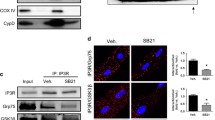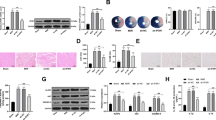Abstract
The calcium-sensing receptor (CaSR) is a G protein-coupled receptor (GPCR) that activates intracellular effectors; for example, it causes inositol phosphate (IP) and 1,2 diacylglycerol (DAG) accumulation, stimulating the release of intracellular calcium and the activation of the protein kinase Cs (PKCs). The activation of CaSR by ischemia/reperfusion (I/R) induces cardiomyocyte apoptosis through the mitochondrial apoptotic pathway; however, the underlying mechanisms remain unclear. In this study, rat hearts were subjected to 30 min of ischemia followed by 2 h of reperfusion in the presence of a CaSR activator, GdCl3. Our results revealed that, under these conditions, the expression of CaSR was increased, the number of apoptotic cardiomyocytes was significantly increased (as shown by terminal deoxy-nucleotidyl transferase-mediated dUTP nick end labeling (TUNEL) assay) and the cells with a typical apoptotic morphology were observed using transmission electron microscopy. Our data further showed that mitochondria isolated from hearts that had undergone I/R combined with GdCl3 exhibited a significant increase in the translocation of phosphorylated PKCδ to the mitochondria, an increase in cytochrome c (cyt c) release from the mitochondria and a marked decrease in mitochondrial potential. The administration of rottlerin, an inhibitor of PKCδ, significantly reduced reperfusion-induced apoptosis, phospho-PKCδ translocation to the mitochondria and the release of cyt c from the mitochondria. Thus, the involvement of CaSR in cardiac apoptosis through the mitochondrial pathway during I/R with GdCl3 is related to phospho-PKCδ translocation to the mitochondria.






Similar content being viewed by others
References
Yellon DM, Hausenloy DJ (2007) Myocardial reperfusion injury. N Engl J Med 357:1121–1135
Sivaraman V, Hausenloy DJ, Kolvekar S, Hayward M, Yap J, Lawrence D, Di Salvo C, Yellon DM (2009) The divergent roles of protein kinase C epsilon and delta in simulated ischaemia–reperfusion injury in human myocardium. J Mol Cell Cardiol 46:758–764
Ferri KF, Kromer G (2001) Organelle-specific initiation of cell death pathways. Nat Cell Biol 3:E255–E263
Lu FH, Tian ZL, Zhang WH, Zhao YJ et al (2009) Calcium-sensing receptors induce apoptosis in rat cardiomyocytes via the endo(sarco)plasmic reticulum pathway during hypoxia/reoxygenation. Basic Clin Pharmacol Toxicol 106:396–405
An A, Varadarajan SG, Camara A (2001) Blocking Na+/H+ exchange reduces [Na+]i and [Ca2+]i load after ischemia and improves function in intact hearts. Am J Physiol 281:H2396–H2409
Paschen W, Doutheil J (1999) Disturbances of the functioning of endoplasmic reticulum: a key mechanism underlying neuronal cell injury? J Cereb Blood Flow Metab 19:1–18
Brown EM, Bai M, Pollak MR (1998) Familial benign hypocalciuric hypercalcemia and other syndromes of altered responsiveness to extracellular calcium. In: Avioli LV, Krane SM (eds) Metabolic bone disease. Academic Press, New York
Wang R, Xu CQ, Zhao WM, Zhang J, Cao K, Yang B, Wu L (2003) Calcium and polyamine regulated calcium-sensing receptors in cardiac tissues. Eur J Biochem 270:2680–2688
Murriel CL, Churchill E, Inagaki K, Szweda LI, Mochly-Rosen D (2004) Protein kinase Cδ activation induces apoptosis in response to cardiac ischemia and reperfusion damage. J Biol 46:47985–47991
Zhang WH, Lu FH, Zhao YJ, Wang LN et al (2007) Post-conditioning protects rat cardiomyocytes via PKCe-mediated calcium-sensing receptors. Biochem Biophys Res Commun 361:659–664
Reyland ME (2007) Protein kinase Cδ and apoptosis. Biochem Soc Trans 35(part 5):1001–1004
Churchill EN, Mochly-Rosen D (2007) The roles of PKCδ and ε isoenzymes in the regulation of myocardial ischaemia/reperfusion injury. Biochem Soc Trans 35(part 5):1040–1042
Kostyak JC, Hunter JC, Korzick DH (2006) Acute PKCy inhibition limits ischaemia–reperfusion injury in the aged rat heart: role of GSK-3h. Cardiovasc Res 70:325–334
Qi X, Vallentin A, Churchill E, Mochly-Rosen D (2007) δPKC participates in the endoplasmic reticulum stress-induced response in cultured cardiac myocytes and ischemic heart. J Mol Cell Cardiol 43:420–428
Qi X, Mochly-Rosen D (2008) The PKCδ-Abl complex communicates ER stress to the mitochondria—an essential step in subsequent apoptosis. J Cell Sci 121:804–813
Murriel CL, Churchill E, Inagaki K, Szweda LI, Mochly-Rosen D (2004) Protein kinase Cdelta activation induces apoptosis in response to cardiac ischemia and reperfusion damage: a mechanism involving BAD and the mitochondria. J Biol Chem 279:47985–47991
Parekh AB (2003) Store-operated Ca2+ entry: dynamic interplay between endoplasmic reticulum, mitochondria and plasma membrane. J Physiol 547:333–348
Mayhew TM, Lucocq JM, Griffiths G (2001) Relative labelling index: a novel stereological approach to test for non-random immunogold labelling of organelles and membranes on transmission electron microscopy thin sections. J Microsc 205:153–164
Frezza C, Cipolat S, Scorrano L (2007) Organelle isolation: functional mitochondria from mouse liver, muscle and cultured fibroblasts. Nat Protoc 2:287–295
Davey KA, Garlick PB, Warley AW, Southworth R (2007) Immunogold labeling study of the distribution of GLUT-1 and GLUT-4 in cardiac tissue following stimulation by insulin or ischemia. Am J Physiol Heart Circ Physiol 292:H2009–H2019
Ding JW, Tong XH, Yang J, Liu Z-Q et al (2010) Activated protein C protects myocardium via activation of anti-apoptotic pathways of survival in ischemia–reperfused rat heart. J Korean Med Sci 25:1609–1615
Maulik N, Engelman RM, Rousou JA (1999) Ischemic preconditioning reduces apoptosis by upregulating anti-death gene Bcl-2. Circulation 100(19 Suppl):II369–II375
Tao J, Xu H, Yang C (2004) Effect of urocortin on L-type calcium currents in adult rat ventricular myocytes. J Pharmacol Res 50:471–476
Leist M, Sigle B, Castoldi AF (1997) Intracellular adenosine triphosphate concentration: a switch in the decision between apoptosis and necrosis. J Exp Med 185:1481–1486
Petronili V, Penzo D, Scorrano L (2001) The mitochondrial permeability transition, release of cytochrome c and cell death. J Biol Chem 276:12030–12034
Eguchi Y, Shimizu S, Tsujimoto Y (1997) Intracellular ATP levels determine cell death fate by apoptosis and necrosis. Cancer Res 57:1835–1840
Havackova M, Kozichova K, Neckar J, Kolar F, Musters RJ, Novakova O (2010) Up-regulation and redistribution of protein kinase C-δ in chronically hypoxia heart. Mol Cell Biochem 345:271–282
Emoto Y, Manome Y, Meinhardt G, Kisaki H, Kharbanda S, Robertson M et al (1995) Proteolytic activation of protein kinase C delta by an ICE-like protease in apoptotic cells. EMBO J 14:6148–6156
Choi BH, Hur EM, Lee JH, Jun DJ, Kim KT (2006) Protein kinase Cdelta-mediated proteasomal degradation of MAP kinase phosphatase-1 contributes to glutamate-induced neuronal cell death. J Cell Sci 119:1329–1340
Denning MF, Wang Y, Tibudan S, Alkan S, Nickoloff BJ, Qin JZ (2002) Caspase activation and disruption of mitochondrial membrane potential during UV radiation-induced apoptosis of human keratinocytes requires activation of protein kinase C. Cell Death Differ 9:40–52
Brodie C, Blumberg PM (2003) Regulation of cell apoptosis by protein kinase c delta. Apoptosis 8:19–27
Nelson CP, Willets JM, Davies NW, Challiss RAJ, Standen NB (2008) Visualizing the temporal effects of vasoconstrictors on PKC translocation and Ca2+ signaling in single resistance arterial smooth muscle cells. Am J Physiol Cell Physiol 295:C1590–C1601
Acknowledgments
This study was supported by a Yu Weihan grant for excellent young scientists at Harbin Medical University (for Weihua Zhang), and also supported by the National Natural Science Foundation of China (30700288, 81000059, and 81070123) and Heilongjiang Educational Ministry Fund (No. 11541111).
Author information
Authors and Affiliations
Corresponding authors
Additional information
Huishuang Zheng and Jun Liu contributed equally to this work.
Rights and permissions
About this article
Cite this article
Zheng, H., Liu, J., Liu, C. et al. Calcium-sensing receptor activating phosphorylation of PKCδ translocation on mitochondria to induce cardiomyocyte apoptosis during ischemia/reperfusion. Mol Cell Biochem 358, 335–343 (2011). https://doi.org/10.1007/s11010-011-0984-1
Received:
Accepted:
Published:
Issue Date:
DOI: https://doi.org/10.1007/s11010-011-0984-1




